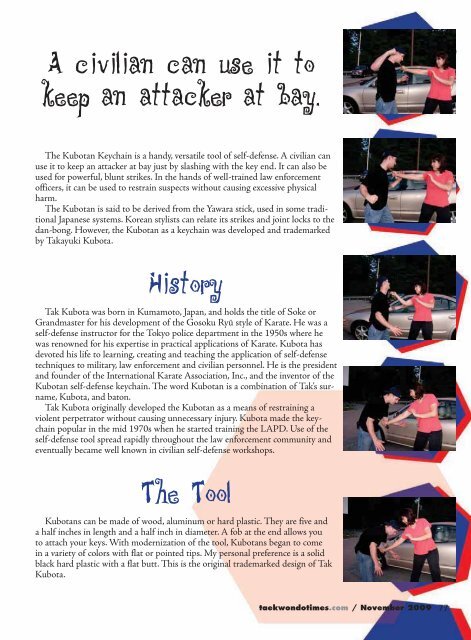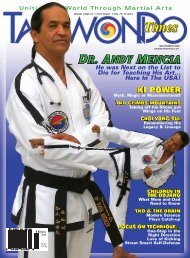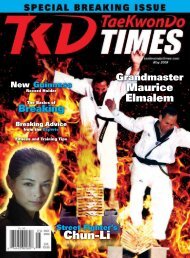Grandmaster Ken MacKenzie - Taekwondo Times
Grandmaster Ken MacKenzie - Taekwondo Times
Grandmaster Ken MacKenzie - Taekwondo Times
Create successful ePaper yourself
Turn your PDF publications into a flip-book with our unique Google optimized e-Paper software.
The Kubotan Keychain is a handy, versatile tool of self-defense. A civilian can<br />
use it to keep an attacker at bay just by slashing with the key end. It can also be<br />
used for powerful, blunt strikes. In the hands of well-trained law enforcement<br />
officers, it can be used to restrain suspects without causing excessive physical<br />
harm.<br />
The Kubotan is said to be derived from the Yawara stick, used in some traditional<br />
Japanese systems. Korean stylists can relate its strikes and joint locks to the<br />
dan-bong. However, the Kubotan as a keychain was developed and trademarked<br />
by Takayuki Kubota.<br />
<br />
Tak Kubota was born in Kumamoto, Japan, and holds the title of Soke or<br />
<strong>Grandmaster</strong> for his development of the Gosoku Ryū style of Karate. He was a<br />
self-defense instructor for the Tokyo police department in the 1950s where he<br />
was renowned for his expertise in practical applications of Karate. Kubota has<br />
devoted his life to learning, creating and teaching the application of self-defense<br />
techniques to military, law enforcement and civilian personnel. He is the president<br />
and founder of the International Karate Association, Inc., and the inventor of the<br />
Kubotan self-defense keychain. The word Kubotan is a combination of Tak’s surname,<br />
Kubota, and baton.<br />
Tak Kubota originally developed the Kubotan as a means of restraining a<br />
violent perpetrator without causing unnecessary injury. Kubota made the keychain<br />
popular in the mid 1970s when he started training the LAPD. Use of the<br />
self-defense tool spread rapidly throughout the law enforcement community and<br />
eventually became well known in civilian self-defense workshops.<br />
<br />
Kubotans can be made of wood, aluminum or hard plastic. They are five and<br />
a half inches in length and a half inch in diameter. A fob at the end allows you<br />
to attach your keys. With modernization of the tool, Kubotans began to come<br />
in a variety of colors with flat or pointed tips. My personal preference is a solid<br />
black hard plastic with a flat butt. This is the original trademarked design of Tak<br />
Kubota.<br />
taekwondotimes.com / November 2009 77













